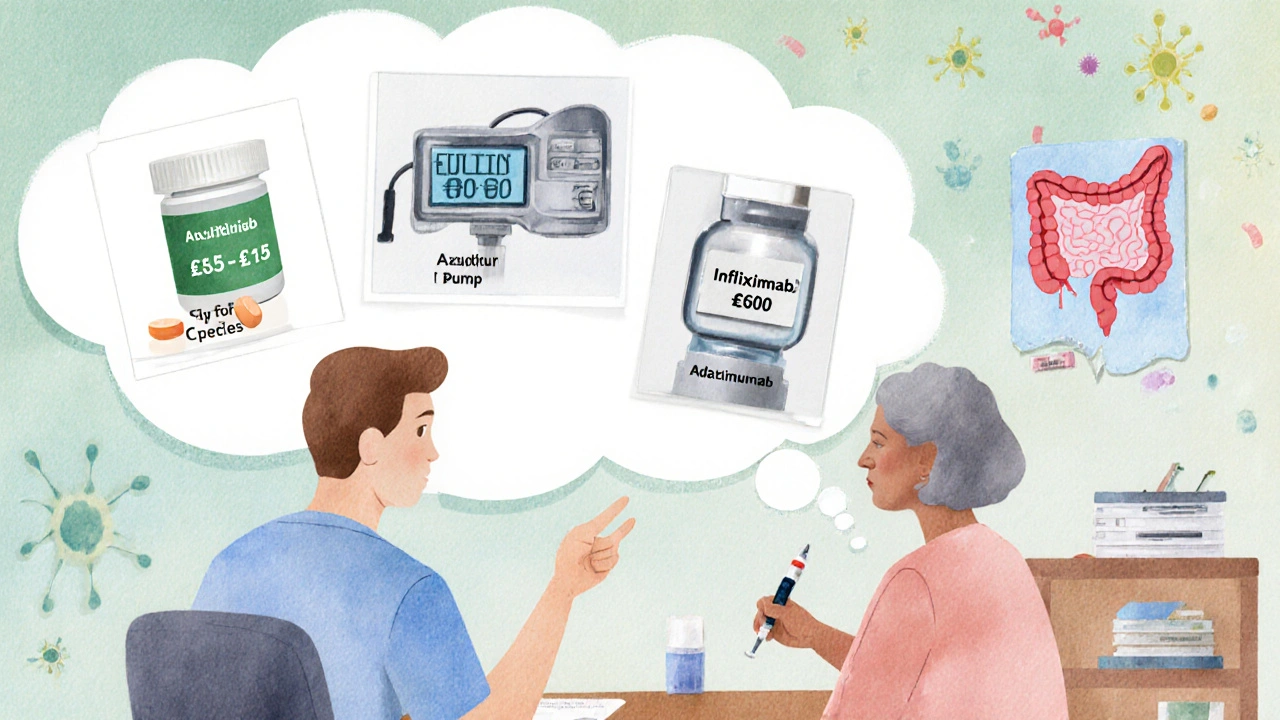IBD Treatment Cost Calculator
IBD Treatment Cost Calculator
Compare monthly and annual costs of IBD medications in the UK based on disease severity and treatment duration.
Results
Key Takeaways
- Azulfidine (sulfasalazine) is a long‑standing oral drug for ulcerative colitis and Crohn’s disease, but newer agents often offer faster relief.
- Mesalamine (5‑ASA) is the go‑to for mild‑to‑moderate ulcerative colitis with fewer systemic side effects.
- Biologics such as infliximab and adalimumab target TNF‑α and are reserved for moderate‑to‑severe disease or when steroids fail.
- Immunomodulators (azathioprine, methotrexate) work slower but can maintain remission and reduce steroid dependence.
- Cost varies widely in the UK: sulfasalazine is cheap (£5‑£15 per month), while biologics run into several hundred pounds per dose.
What is Azulfidine (Sulfasalazine)?
Azulfidine is a sulfonamide‑based pro‑drug that combines sulfapyridine and 5‑aminosalicylic acid (5‑ASA) linked by an azo bond. It was first approved in the 1950s and quickly became a staple for inflammatory bowel disease (IBD) management.
In the UK, it is prescribed under the generic name sulfasalazine. The drug is taken orally, usually in divided doses, and is available in 500mg and 1g tablets.
How Sulfasalazine Works
The azo bond remains intact as the tablet passes through the stomach. Once it reaches the colon, bacterial azoreductases cleave the bond, releasing sulfapyridine (absorbed systemically) and 5‑ASA (acts locally). 5‑ASA suppresses prostaglandin and leukotriene production, reducing inflammation in the intestinal lining.
Sulfapyridine is largely responsible for many of the drug’s side effects, such as nausea, headache, and, in rare cases, photosensitivity.
When Doctors Choose Azulfidine
Typical indications include:
- Mild‑to‑moderate ulcerative colitis (UC) that has not responded to 5‑ASA alone.
- Maintenance therapy for Crohn’s disease (especially colonic disease) when steroids are being tapered.
- Patients who need a cost‑effective oral option and can tolerate sulfonamides.
Because it is taken orally and does not require monitoring for blood levels, it remains attractive in primary care settings.
Alternative IBD Medications
Modern IBD treatment offers a range of options, each with distinct mechanisms, efficacy profiles, and costs. Below is a quick snapshot of the most common alternatives.
Mesalamine (5‑ASA) - an anti‑inflammatory compound delivered directly to the colon without the sulfapyridine component.
Infliximab - a chimeric monoclonal antibody that neutralises tumour necrosis factor‑alpha (TNF‑α), administered intravenously.
Adalimumab - a fully human anti‑TNF‑α antibody given subcutaneously.
Azathioprine - a purine analogue that interferes with DNA synthesis, reducing immune cell proliferation.
Methotrexate - a folate antagonist that dampens inflammation, used both orally and by injection.
Budesonide - a locally acting corticosteroid formulated for ileo‑colonic release.
Comparison Table
| Drug | Mechanism | Primary Indications | Formulation | Common Side Effects | Typical Monthly Cost (£) |
|---|---|---|---|---|---|
| Sulfasalazine (Azulfidine) | Pro‑drug; releases 5‑ASA + sulfapyridine in colon | UC, colonic Crohn's | Oral tablets 500mg / 1g | Nausea, headache, photosensitivity, rash | 5‑15 |
| Mesalamine | Direct 5‑ASA delivery | Mild‑moderate UC | Oral tablets, rectal suppositories | Abdominal pain, flatulence | 20‑40 |
| Infliximab | Anti‑TNF‑α monoclonal antibody | Moderate‑severe UC & Crohn's, fistulising Crohn's | IV infusion (5mg/kg) | Infusion reactions, infections, lupus‑like syndrome | 600‑900 (per infusion, every 8weeks) |
| Adalimumab | Anti‑TNF‑α monoclonal antibody | Moderate‑severe UC & Crohn's | Subcutaneous injection (40mg every 2weeks) | Injection site pain, infections, headache | 450‑550 (monthly) |
| Azathioprine | Purine synthesis inhibitor | Maintenance for Crohn's, steroid‑sparing | Oral tablets 25‑150mg daily | Leukopenia, liver enzyme rise, nausea | 30‑50 |
| Methotrexate | Folate antagonist, anti‑inflammatory | Crohn's (especially perianal), steroid‑sparing | Oral 10‑25mg weekly or IM injection | Liver toxicity, mouth ulcers, pulmonary issues | 25‑40 |
| Budesonide | Locally acting corticosteroid | Ileocolonic Crohn's, mild‑moderate UC | Oral controlled‑release 9mg daily | Oral thrush, mild systemic steroid effects | 35‑55 |
Pros and Cons of Each Option
Azulfidine (Sulfasalazine)
- Pros: inexpensive, oral dosing, effective for colonic disease, long safety record.
- Cons: sulfapyridine‑related side effects, requires weekly blood count in some patients, slower onset than biologics.
Mesalamine
- Pros: fewer systemic side effects, targeted 5‑ASA delivery, good for maintenance.
- Cons: higher cost, less effective for moderate disease, adherence challenges with multiple daily doses.
Infliximab
- Pros: rapid induction of remission, works for fistulas, strong evidence in severe IBD.
- Cons: IV infusion logistics, higher infection risk, expensive, antibody formation may reduce efficacy.
Adalimumab
- Pros: self‑administered subcutaneous injection, flexible dosing, effective for both UC and Crohn's.
- Cons: similar infection risk to other biologics, cost, injection site reactions.
Azathioprine
- Pros: helps maintain remission, steroid‑sparing, relatively cheap.
- Cons: slow onset (up to 3‑6months), requires TPMT testing, risk of bone marrow suppression.
Methotrexate
- Pros: useful for Crohn's when azathioprine fails, oral or injectable forms.
- Cons: hepatotoxicity monitoring needed, teratogenic, may cause lung issues.
Budesonide
- Pros: potent local steroid effect with minimal systemic exposure, useful for flare‑ups.
- Cons: not suitable for long‑term maintenance, can cause mild adrenal suppression.

How to Choose the Right Medication
- Assess disease severity. Mild‑to‑moderate UC often responds to 5‑ASA (mesalamine) or sulfonamide combos (azulfidine). Moderate‑to‑severe disease usually needs biologics or immunomodulators.
- Consider location of inflammation. Colonic disease leans toward sulfasalazine or mesalamine; ileal or perianal Crohn’s may need budesonide, methotrexate, or biologics.
- Check for contraindications. Sulfonamide allergy rules out azulfidine. Pregnancy, liver disease, or TPMT deficiency influence azathioprine/methotrexate choices.
- Factor in cost and access. NHS formularies provide free azulfidine and mesalamine; biologics often require special approval and may be accessed via hospital pharmacy.
- Plan monitoring. Azathioprine needs blood counts and liver enzymes; infliximab needs infection screening; budesonide needs cortisol checks if long‑term.
In practice, many clinicians start with an inexpensive oral agent (azulfidine or mesalamine) and only step up to biologics if remission isn’t achieved within 8‑12weeks.
Frequently Asked Questions
Frequently Asked Questions
Can I take Azulfidine if I’m allergic to sulfa drugs?
No. Azulfidine contains a sulfonamide component (sulfapyridine). Patients with known sulfa allergy should use a sulfonamide‑free alternative like mesalamine or a biologic.
How long does it take for sulfasalazine to work?
Clinical response typically appears after 4‑6weeks, with full remission possible by 8‑12weeks. Some patients notice symptom relief sooner, but it’s slower than biologics.
Is regular blood testing needed while on Azulfidine?
Most guidelines recommend a baseline CBC and liver panel, then repeat tests at 2‑3months. If the dose is stable and labs stay normal, testing can be spaced to yearly reviews.
When should I consider switching from Azulfidine to a biologic?
If you haven’t achieved clinical remission after 12weeks of a therapeutic dose, or if disease flares despite adherence, it’s time to discuss escalation to an anti‑TNF agent (infliximab or adalimumab) or to an immunomodulator.
Are there any dietary tips that improve sulfasalazine effectiveness?
Taking the tablet with food reduces nausea. A balanced low‑residue diet can lessen stool frequency during the initial weeks, but long‑term dietary restrictions aren’t required.
Bottom Line
Azulfidine remains a viable, low‑cost option for patients with colonic IBD who can tolerate sulfonamides. However, its side‑effect profile and slower onset mean many clinicians reserve it for milder disease or for maintenance after a biologic‑induced remission. By weighing severity, location, safety, and cost, you can pick the drug that matches your lifestyle and health goals.



Comments
While the article paints sulfasalazine as a budget‑friendly hero, the hidden laboratory costs and the need for regular blood monitoring suggest the real expense may be obscured. Moreover, the claim of “slow onset” disregards the pharmacokinetic nuances that can vary wildly among patients. It’s not merely a matter of price tags; the long‑term safety profile demands a more skeptical view.
Great point! 😊 The hidden costs can indeed add up, especially if you need frequent lab work. Keeping an eye on those details helps everyone make smarter choices. 👍
In the grand scheme of IBD management, sulfasalazine still holds a respectable place, particularly for those who cannot afford the newer biologics. It's inexpensive, oral, and has a decades‑long safety record, though side‑effects like photosensitivity can be a bother. If you can tolerate sulfonamides, it's definitely worth a trial before jumping to higher‑cost options.
Let me unpack this a bit: the article gives sulfasalazine a cursory nod, but it omits the fact that the drug’s efficacy is tightly linked to gut bacterial composition, which varies not just between individuals but also fluctuates over time due to diet, antibiotics, and even stress levels. Consequently, a patient who initially responds well may later find the medication less effective, prompting a costly switch to biologics mid‑treatment. Additionally, the sulfapyridine moiety, while useful for certain anti‑inflammatory pathways, is responsible for a host of adverse reactions – ranging from mild nausea to severe hypersensitivity syndromes that can necessitate hospitalization. In practice, many clinicians pre‑emptively order baseline CBC and liver panels, but the frequency of follow‑up monitoring can increase the overall cost burden beyond the stated £5‑£15 per month. The pharmacoeconomic analyses frequently ignore indirect costs such as lost workdays during flare‑ups caused by suboptimal response. Moreover, the article’s table lists “£0/month” for many biologics, which is obviously a placeholder and misleading for patients trying to budget their care. The reality is that infliximab infusions run into several hundred pounds per dose, and adalimumab, while subcutaneous, still demands a monthly outlay that eclipses sulfasalazine by an order of magnitude. It is also worth noting that insurance formularies occasionally restrict the use of sulfasalazine to those without contraindications to sulfonamides, thereby limiting its applicability. Finally, the claim that sulfasalazine is “slow to act” is overstated; clinical remission can be observed as early as four weeks, though true mucosal healing often takes longer, a nuance that patients should be counseled on to set realistic expectations. All in all, while sulfasalazine remains a cost‑effective entry point, the decision matrix is far more complex than the article suggests.
Costs don’t tell the whole story.
Okay, I’ve been on sulfasalazine for a year and honestly it felt like a roller‑coaster – the nausea hit hard at first, then the joint pain crept in, and I was constantly checking my blood work. Still, after a few months I could finally ditch steroids, so the drama was worth it, I guess. It’s not a miracle drug, but if you’re strapped for cash, it’s a decent start.
Sounds like you’ve been through the wringer but made it work. The balance between side effects and cost is always a tricky dance.
Wow, another post trying to convince us that cheap pills are the holy grail of IBD treatment 😏. Let’s be real: sulfasalazine might be wallet‑friendly, but the side‑effects can feel like a slow‑burn apocalypse for some patients. Headaches, photosensitivity, and that “I‑feel‑off” feeling can make you question whether you’re actually treating the disease or just trading one set of symptoms for another. And don’t get me started on the weekly blood‑work – it’s like the pharma industry’s way of saying, “Sure, take this cheap drug, but we’ll keep you in the clinic forever.” If you’re looking for a truly modern approach, you might want to explore the newer agents that, while pricier, don’t come with the same sulfa‑related baggage. So yeah, cheap? Yes. Worth it? Depends on your tolerance and your doctor’s willingness to monitor you like a hawk.
🧐
Listen, you’re being a bit melodramatic about a drug that’s saved countless folks from steroid‑dependence. If we let the cost debate sway every doctor’s decision, we’ll be back to the dark ages of cheap pills with no innovation. The UK NHS has proven that even the “old‑school” meds can be effective when used properly, and you can’t dismiss that just because you’ve read a few side‑effect headlines. Let’s stop whining and focus on what works for the patient, not what the headline‑grabbers want us to believe.
Hey folks! If you’re feeling overwhelmed by the sea of options, start with the cheapest, safest oral medication that fits your disease pattern. Sulfasalazine can be a solid first step for colonic disease, and it’s amazing how many people see an improvement without breaking the bank. Stick with it for a couple of months, monitor your labs, and if you don’t hit remission, then consider stepping up. Keep your spirits up – there’s a path forward for everyone.
Indeed, initiating therapy with an economical agent aligns with stewardship principles. Nevertheless, vigilant monitoring is indispensable to preempt adverse events.
Right on, staying cost‑effective while keeping an eye on outcomes is the sweet spot. If you hit a wall, there’s always a step‑up plan, and the community here can share experiences on switching strategies.
Let's cut through the fluff: the article’s table is a sloppy snapshot, and anyone who thinks a simple cost comparison captures the complexity of IBD therapy is either naive or willfully ignorant. The side‑effect profiles, pharmacodynamics, and patient‑specific variables matter far more than a monthly price tag. In fact, the so‑called “cheap” sulfasalazine can become expensive when you factor in the cost of managing sulfapyridine‑induced rashes and the inevitable lab work. If you ignore those nuances, you’re selling patients a false economy.
Honestly, the article oversimplifies. Real‑world practice demands a nuanced approach, and those who cling to cheapness alone ignore the bigger picture of disease control and quality of life.
Wow, this discussion really highlights how personal the journey with IBD can be. 🌍 I’ve seen patients swing from sulfasalazine to biologics and back, each time learning more about what their gut actually tolerates. It’s fascinating how diet, stress, and even geography can influence drug metabolism – something the original post barely touched on. 🦠 When I was first diagnosed, my gastroenterologist suggested starting with a 5‑ASA agent because it was the least invasive, but the side‑effects were so intense that I had to pivot to an immunomodulator within weeks. 🚀 That experience taught me that cost is only one piece of the puzzle; we need to balance efficacy, safety, and lifestyle compatibility. It also reminded me of the importance of patient advocacy – never be afraid to ask for a medication review if something isn't working. 🙏 In the UK, the NHS sometimes restricts newer therapies, but I found that a well‑written appeal backed by recent lab trends can open doors to biologics earlier than the standard ladder. 🎉 Bottom line: stay informed, keep an open dialogue with your care team, and remember that every patient’s path is unique. 🌟
Great perspective, especially about the need for advocacy. The more patients speak up, the quicker pathways can evolve.
If you’re weighing costs, remember that the total cost of care includes clinic visits, lab monitoring, and potential hospitalizations due to flares. An upfront cheap drug may lead to higher downstream expenses if disease control isn't achieved. A balanced approach that considers both drug price and overall disease management budget often yields the best outcomes.
Sure, but arguing that cheap meds are always better ignores the reality that many patients simply can’t tolerate them. It’s not about being contrarian; it’s about acknowledging that one size does not fit all.
Valid point. Tolerability is a critical factor, and we should tailor therapy to each individual’s response and side‑effect profile.
In the end, it’s about defending our national health budget while giving patients options. We can’t just throw money at every new drug; we need to prioritize what truly works.